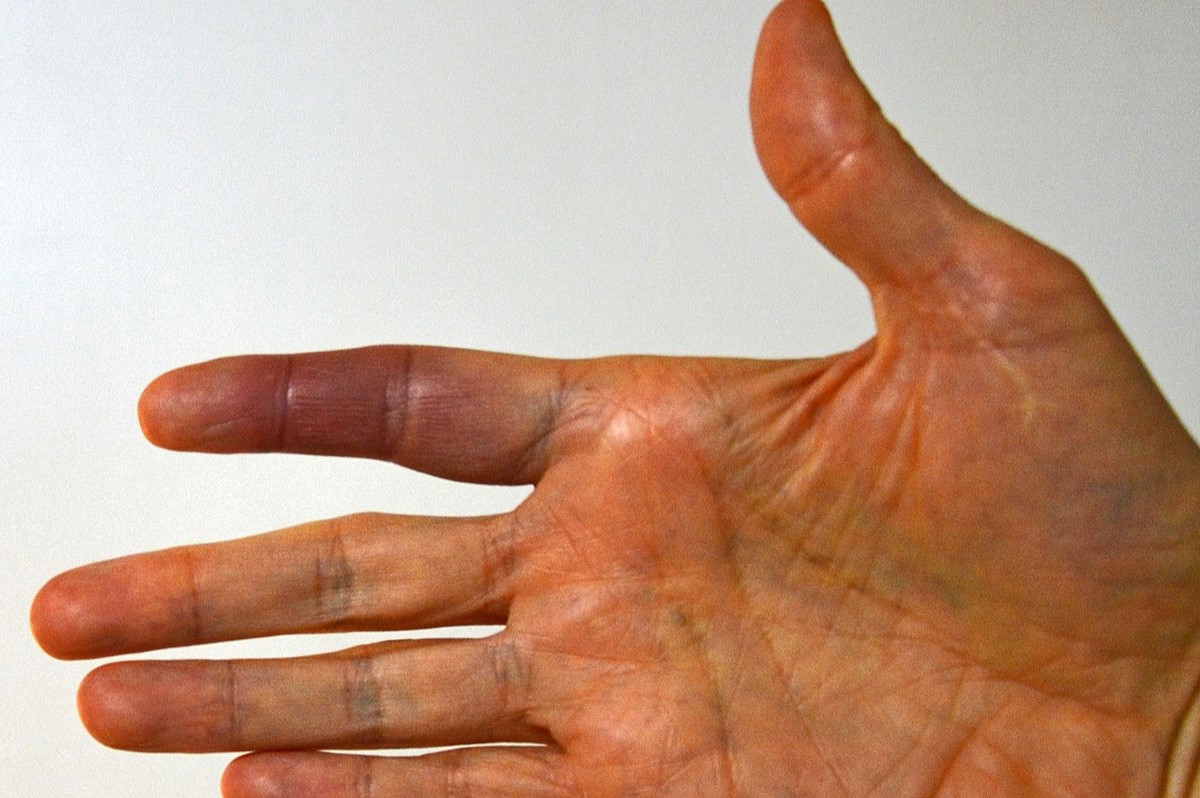
Have you ever experienced sudden pain and swelling in your hand, followed by a mysterious blue discoloration? You might be dealing with Paroxysmal Hand Hematoma, also known as Achenbach syndrome. This rare, benign condition causes spontaneous bleeding under the skin of the hand, typically affecting the palm or fingers. While it can be alarming, especially with its sudden onset and striking symptoms, it usually resolves on its own within a few days. Affecting mostly middle-aged women, this condition remains largely unknown, even among healthcare providers. Understanding its characteristics can help alleviate unnecessary worry and avoid needless medical tests.
Key Takeaways:
- Paroxysmal hand hematoma, also known as Achenbach syndrome, is a rare condition that causes sudden painful swelling and blue discoloration in the hands. It usually resolves on its own within a few days.
- Middle-aged women are most commonly affected by paroxysmal hand hematoma, with symptoms including pain, swelling, and blue discoloration in the fingers. Despite its alarming appearance, it is generally harmless and does not require specific treatment.
What is Paroxysmal Hand Hematoma?
Paroxysmal hand hematoma, also known as Achenbach syndrome, is a rare condition that can cause sudden and alarming symptoms in the hands. Despite its dramatic presentation, it is generally harmless and resolves on its own. Let's dive into some key facts about this intriguing condition.
-
Definition: Paroxysmal hand hematoma involves spontaneous bleeding into the skin of the hand, usually on the palm or fingers.
-
Other Names: This condition is also called Achenbach syndrome, acute idiopathic blue finger, or paroxysmal finger hematoma.
-
First Description: German physician Walter Achenbach first described this condition in 1958.
-
Prevalence: Fewer than 100 cases have been reported in medical literature, making it quite rare.
Who Gets Affected?
Understanding who is most likely to experience paroxysmal hand hematoma can help in recognizing and diagnosing the condition.
-
Demographics: Middle-aged women are most commonly affected, with a median age of 49.5 years.
-
Gender Predominance: Women are more likely to develop this condition compared to men.
-
Age Range: While it can affect people of various ages, middle-aged individuals are most frequently diagnosed.
Symptoms and Clinical Presentation
The symptoms of paroxysmal hand hematoma can be quite startling but are usually not serious. Here’s what to look out for.
-
Symptoms: Sudden onset of painful swelling in the fingers, followed by blue discoloration.
-
Clinical Presentation: Typically presents with acute pain on the volar aspect of one or more digits, followed by blue discoloration.
-
Anatomy Involved: Often affects the palmar surface of the fingers, especially around the proximal interphalangeal joint creases.
-
Duration: Symptoms usually resolve on their own within a few days, often within 3 days.
Causes and Risk Factors
While the exact cause remains unknown, some theories and observations provide clues about what might trigger this condition.
-
Pathophysiology: The exact cause is unknown, but local vascular fragility might play a role.
-
Risk Factors: No known risk factors like trauma, drug use, bleeding disorders, or rheumatologic diseases are associated with this syndrome.
-
Triggering Factors: Some cases have been linked to twisting or gripping movements.
Pain and Discoloration
The pain and discoloration are the most noticeable symptoms. Here’s what you need to know about these aspects.
-
Pain and Swelling: Transient localized pain and swelling are the primary symptoms.
-
Blue Discoloration: The blue color comes from blood accumulating under the skin, which can look alarming but isn't dangerous.
-
Paresthesia: Some patients may feel tingling or numbness in the affected area.
-
Edema: Localized swelling of the affected fingers is common.
Diagnosis and Misdiagnosis
Diagnosing paroxysmal hand hematoma can be tricky due to its rare nature and nonspecific symptoms.
-
Diagnostic Challenges: The condition can be hard to diagnose because of its nonspecific symptoms and lack of clear diagnostic criteria.
-
Avoiding Misdiagnosis: Misdiagnosis is common, leading to unnecessary and potentially harmful procedures like tissue biopsy and catheter-based angiography.
-
Awareness Importance: Knowing about this benign, self-limiting syndrome is crucial to avoid unnecessary tests and ease patient anxiety.
Treatment and Management
Despite its alarming symptoms, paroxysmal hand hematoma usually doesn’t require specific treatment.
-
Self-Resolving Nature: The condition resolves on its own without any specific treatment.
-
Symptomatic Treatment: Cold compresses and oral ibuprofen can help manage pain and discomfort.
-
No Specific Treatment Required: Symptoms resolve spontaneously within a few days, so no specific treatment is needed.
Clinical Examination and Differential Diagnosis
A thorough clinical examination is essential to rule out other conditions that might mimic paroxysmal hand hematoma.
-
Clinical Examination: Detailed examination is crucial to rule out other conditions like Raynaud phenomenon or thromboembolism.
-
Differential Diagnosis: Conditions like Raynaud phenomenon, autoinflammatory diseases, and thromboembolic events need to be ruled out through clinical evaluation and tests.
Laboratory and Imaging Studies
Laboratory and imaging studies often show normal results, helping to confirm the diagnosis of paroxysmal hand hematoma.
-
Laboratory Findings: Routine lab tests and Doppler studies of the arteries usually show normal results, indicating no underlying disorders.
-
Normal Hematological Profile: Lab investigations typically show a normal hematological profile, ruling out bleeding disorders or coagulopathy.
-
Ultrasound Doppler Studies: Doppler studies of the arteries are usually normal, indicating no vascular abnormalities.
Case Reports and Series
Documented cases and series help increase awareness and understanding of this rare condition.
-
Case Reports: Several case reports document the presentation and resolution of paroxysmal hand hematoma, highlighting its benign nature.
-
Case Series: A 2022 case series presented four patients with symptoms compatible with Achenbach syndrome, aiming to increase awareness.
Variability in Clinical Presentation
The symptoms can vary, making it important to recognize different presentations of the condition.
-
Clinical Presentation Variability: Some cases present with painless bruising, while others have painful swelling and discoloration.
-
Index and Middle Fingers Affected: The index and middle fingers are most commonly affected, though other fingers can also be involved.
-
Palmar and Dorsal Aspects Affected: Both the palmar and dorsal aspects of the hand can be affected, though it’s more pronounced on the palmar surface.
Importance of Awareness
Awareness among healthcare providers is crucial to ensure proper management and reassurance for patients.
-
General Practitioner Awareness: Awareness among general practitioners is vital to reassure patients and avoid unnecessary investigations.
-
Phlebectasia: Some cases may show phlebectasia (dilation of superficial veins), contributing to symptoms.
-
Warm Extremities: Extremities are often warm, and peripheral pulses are palpable and of good volume, indicating no vascular issues.
-
Normal Hematological Profile: Lab investigations typically show a normal hematological profile, ruling out any underlying bleeding disorders or coagulopathy.
-
Ultrasound Doppler Studies: Doppler studies of the arteries are usually normal, indicating no vascular abnormalities.
-
Case Reports: Several case reports document the presentation and resolution of paroxysmal hand hematoma, highlighting its benign nature and self-limiting course.
Understanding Paroxysmal Hand Hematoma
Paroxysmal hand hematoma, or Achenbach syndrome, is a rare but benign condition. It causes sudden, painful swelling and blue discoloration in the hands, especially the fingers. Despite its alarming appearance, it’s self-limiting and resolves on its own within days. Affecting mainly middle-aged women, this condition doesn’t require specific treatment. Awareness is key to avoid unnecessary tests and to reassure patients. Symptoms like pain, swelling, and discoloration can be managed with cold compresses and pain relievers. No underlying vascular or hematologic issues are typically found, making it a straightforward diagnosis once recognized. Knowing these facts helps in understanding and managing this rare condition effectively.
Frequently Asked Questions
Was this page helpful?
Our commitment to delivering trustworthy and engaging content is at the heart of what we do. Each fact on our site is contributed by real users like you, bringing a wealth of diverse insights and information. To ensure the highest standards of accuracy and reliability, our dedicated editors meticulously review each submission. This process guarantees that the facts we share are not only fascinating but also credible. Trust in our commitment to quality and authenticity as you explore and learn with us.


